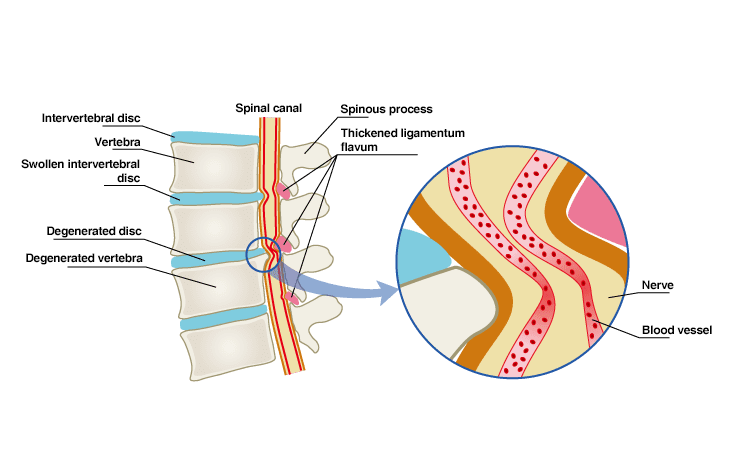Column The Different Surgical Procedures for Spinal Canal Stenosis: Advantages and Disadvantages of Each Method at a Glance.
May, 16, 2025
Spinal canal stenosis is a condition in which the spinal canal, which acts as the pathway for the nerves, becomes narrowed, resulting in compression of the nerves. When caused by instability of the lumbar spine, it often causes pain during physical movement.
Together with lumbar spinal stenosis, numbness and pain from the waist down soon start to appear. This is characterized by a condition called intermittent claudication, in which walking causes pain and numbness in the buttocks and legs, but which eases when resting, before returning when walking is resumed.

The most prevalent treatment for spinal stenosis is spinal surgery.
There are several surgical methods available, which we will introduce in this article.
The Different Surgeries for Spinal Canal Stenosis
Lumbar spinal canal stenosis can first be treated with block injections, but the stronger the pain and numbness, the more likely surgery is to be considered.
Lumbar laminectomy
This surgery is performed using an endoscope.
Under general anesthesia, an 18-20 mm skin incision is made on the back and an endoscopic tube is passed through to remove nerve compression and widen the spinal canal by removing a portion of the vertebral arch and thickened ligamentum flavum.
・Advantages:
Since it does not require to make a large cut in the back muscles, the loss of spinal stability is negligible.
It is also covered by health insurance.
・Disadvantages:
Hospitalization takes about one week.
Symptoms may remain if not enough tissue is removed.
If the patient also has spondylolisthesis or intervertebral foramen stenosis, fusion may be necessary after the resection is performed.
The surgical technique requires skill, and only specialized hospitals are able to perform the surgery.
Spinal fusion
This is a surgery used to fix the spine that is performed with the help of an endoscope and fluoroscopic equipment.
Under general anesthesia, an incision is made on the skin of the back, the degenerated disc is removed, and an artificial device called a cage filled with bone tissue taken from the hip bone is inserted to reshape the spine. Screws and rods are then used to secure the vertebrae.
・Advantages:
Applicable to cases involving lumbar spondylolisthesis and instability.
Covered by health insurance.
・Disadvantages:
Invasive procedure, resulting in a large scar.
Hospitalization is long, lasting one to two weeks.
Muscles may be injured by the metal screws that enter the body, and movements of the lower back may be restricted.
Once immobilized, the area involved cannot move ever again.
After surgery, adjacent discs and other parts of the body become stressed, which may cause spinal canal stenosis or herniated discs.
If the bones have been weakened by osteoporosis, the immobilized spine may lose its volume.
There is a high possibility of pus accumulating in the operated area.
Radiofrequency ablation, Pulsed RF
Under local anesthesia, high-frequency current is applied through the tip of a needle to block pain signals through ablation of the nerves.
The effect lasts until the blocked nerve regenerates.
・Advantages:
Hospitalization required for one night only.
Does not affect nerves that are not involved in the pain signal.
・Disadvantages:
Not indicated for all patients.
The effect is temporary, and the pain returns within a few months to a year, so multiple interventions may be necessary.
Since it is not possible to block every nerve that causes pain, it is necessary to carefully determine if they can be blocked by identifying the nerves that cause the pain in advance.
The treatment at our clinic: The Cellgel Method
Our clinic performs the Cellgel method for spinal canal stenosis. It is one of the most advanced treatment methods that have been researched and developed in recent years and is a newest treatment method backed by solid evidence.
Spinal canal stenosis occurs when a crack occurs in a disc, causing its central component to leak out, and the protruding portion then narrows the spinal canal. If the cracked disc is not repaired, it can herniate again or narrow the spinal canal again.
The Cellgel procedure available at our clinic provides a fundamental treatment by injecting a drug that fills in the cracks in the disc, which then becomes a gel that fills in the cracks. It is characterized by the fact that the volume of the disc is not reduced, and the drug remains in the disc as a gel-like implant after treatment, contributing to the preservation of the disc.
・Advantages:
It provides a treatment at root level because it is capable of “restoring the disc,” which is not possible with other treatment methods.
It is applicable to a wide range of diseases.
No hospitalization is required, and the treatment can be done on the same day.
Treatment is also available for patients who still have pain after surgery, or which has recurred.
Treatment is also available for elderly patients, even if they are 80 years old or older.
・Disadvantages:
The treatment is not applicable to cases where the intervertebral disc has almost completely lost its volume.
The treatment cost is high because it is an out-of-pocket treatment.
If you have been diagnosed with spinal canal stenosis or are suffering from it, or if you wish to avoid spinal surgery, please consider having a consultation at our clinic.
Related Articles
How to Treat Chronic Back Pain: Finding the Right Treatment for Your Condition



